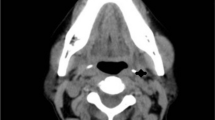Abstract
Purpose
Elongated styloid process results in severe cranio-facial/cervico-facial pain. The purpose of this study is to determine the efficacy of treatment outcomes using transcervical approach in the management of styloid-stylohyoid syndrome/styloid syndrome.
Study design
This is a retrospective cohort study. Subjects were enrolled from out-patient clinics reporting between the periods Jan 2016–Jan 2018.
Methods & methods
Twelve patients diagnosed with styloid syndrome based on history, thorough clinical workup, and assessment were included in the study. The primary outcomes—improvement in pain and regression of chief complaints following surgery were assessed. Elongated styloid was resected using transcervical approach under general anesthesia.
Results
The intra-operative lengths of the styloid process varied from 40 to 43 mm. No post-operative complications were encountered and the symptoms regressed completely after surgery in all the patients at follow-up of 6 months.
Conclusions
Transcervical styloidectomy is an effective treatment for exposure and resection of the styloid process with minimal complications in patients with stylo-stylohyoid syndrome.




Similar content being viewed by others
References
Eagle WW (1937) Elongated styloid process: report of 2 cases. Arch Otolaryngol 25:584–587
Balcioglu HA, Kilic C, Akyol M, Ozan H, Kokten G (2009) Length of the styloid process and anatomical implications for Eagle’s syndrome. Folia Morphol (Warsz) 68(4):265–270
Murtagh RD, Caracciolo JT, Fernandez G (2001) CT findings associated with eagle syndrome. AJNR Am J Neuroradiol 22(7):1401–1402
Okur A, Ozkırış M, Serin HI et al (2014) Is there a relationship between symptoms of patients and tomographic characteristics of styloid process? Surg Radiol Anat 36(7):627–632
Kawasaki M, Hatashima S, Matsuda T (2012) Non-surgical therapy for bilateral glossopharyngeal neuralgia caused by Eagle’s syndrome, diagnosed by three-dimensional computed tomography: a case report. J Anesth 26(6):918–921
Kim E, Hansen K, Frizzi J (2008) Eagle syndrome: case report and review of the literature. Ear Nose Throat J 87(11):631–633
Raina D, Gothi R, Rajan S (2009) Eagle syndrome. Indian J Radiol Imaging 19(2):107–108
Costantinides F, Vidoni G, Bodin C, Di Lenarda R (2013) Eagle’s syndrome: signs and symptoms. Cranio 31(1):56–60
Leong SCL, Karkos PD, Papouliakos SM, Apostolidou MT. Unusual complications of tonsillectomy: a systematic review. Am J Otolaryngol. 28(6):419–422
Öztaş B, Orhan K (2012) Investigation of the incidence of stylohyoid ligament calcifications with panoramic radiographs. J Investig Clin Dent 3(1):30–35
Camarda AJ, Deschamps C, Forest DI (1989) Stylohyoid chain ossification: a discussion of etiology. Oral Surg Oral Med Oral Pathol 67:515–520
Sivers JE, Johnson GK, Lincoln MS (1985) Diagnosis of Eagle’s syndrome. Oral Surg Oral Med Oral Pathol 59:575–577
Verma R (1996) Stylagia. Indian J Otolaryngol Head Neck Surg 48(4):312–314
Buono U, Mangone GM, Michelotti A, Longo F, Califano L (2005) Surgical approach to the stylohyoid process in Eagle's syndrome. J Oral Maxillofac Surg 63(5):714–716
Chase DC, Zarmen A, Bigelow WC, McCoy JM (1986) Eagle's syndrome: a comparison of intraoral versus extraoral surgical approaches. Oral Surg Oral Med Oral Pathol 62:625–629
Beder E, Ozgursoy OB, Ozgursoy SK (2005) Current diagnosis and transoral surgical treatment of Eagle's syndrome. J Oral Maxillofac Surg 63:1742–1745
Author information
Authors and Affiliations
Corresponding author
Ethics declarations
Conflict of interest
The authors declare that they have no conflict of interest.
Informed consent
Yes.
Ethical approval
Ethical approval was obtained from the institutional ethical committee.
Rights and permissions
About this article
Cite this article
Jose, A., Arya, S., Nagori, S.A. et al. Styloid-stylohyoid syndrome: a rare cause of cranio-facial pain—a retrospective case series of 12 patients. Oral Maxillofac Surg 23, 47–51 (2019). https://doi.org/10.1007/s10006-018-0736-4
Received:
Accepted:
Published:
Issue Date:
DOI: https://doi.org/10.1007/s10006-018-0736-4




